At SPA+CLINIC we are always looking for ways to help you grow and diversify your business; looking at trends to tap into, networks to cultivate and markets to explore.
One of the biggest opportunities for 2016 will be the men’s market – male aesthetics is on the march.
Leading Sydney plastic surgeon Dr Darryl Hodgkinson tells us that his male patient base has grown substantially in the last few years and describes the surgical and non-surgical procedures they are seeking.
This gives you, as salon, spa and clinics professionals, a vital glimpse into the services you can be offering to attract more men .
If they are seeking plastic surgery to enhance their facial features, for example, it logically follows that they will also be keen to optimise and maintain the results with tailored professional skincare.
We will be addressing these opportunities in future stories.
Here Dr Hodgkinson* gives a peek into a man’s world:
Cosmetic surgery for men constitutes an ever-increasing percentage of cases for most busy cosmetic surgical practices in major urban centres.
Although there are many cosmetic surgical procedures common to both men and women, some are exclusive to men.
In my personal practice of over 20 years in the eastern suburbs of Sydney, the percentage of male cases has grown over the last 10 years from 20 to 30 percent of total surgical procedures.
The most popular male procedures are rhinoplasty (nose surgery), liposuction, facial rejuvenation surgery (facelifts and eyelid surgery), gynaecomastia (man boobs) and body contour procedures and implants.
Hair transplantation tends to be a specialised area in and of itself and is not usually carried out by general cosmetic or plastic surgeons but widely sought after by prematurely balding men.
Non-surgical treatments are also on the rise, in particular anti-wrinkle injections for frown lines between the eyes and wrinkles or crows feet around the eyes.
Injectable fillers also are commonly used in men with deep nasolabial folds which, left untreated, can give a man an aggressive appearance. These fillers are used to plump out and soften the appearance.
There is virtually no stigma surrounding male cosmetic surgery anymore and cosmetic surgery is often encouraged by a patient’s partner, wife or girlfriend who may or may not have had some surgery themselves.
MOTIVATION FOR SURGERY
Men can often be pragmatic about their reasons for seeking surgery. For instance, I had a patient who was a farmer from the back of Bourke who wanted his ears reduced and pinned back so that he could wear his broad rimmed sun hat more comfortably.
Men also are also quite forthright about addressing their ageing process. Since they get to look at their face every day when shaving they notice the sagging of the jawline and the slacking of the neck in their 40s to 60s.
Men who find themselves back in the dating game after a divorce or split are often keen to re-establish their youthful appearance, and with it the confidence that they once had.
In these circumstances, they often seek eyelid surgery, especially if they have baggy lower eyelids or heavy upper lids and, depending on their age, a facelift or minimally invasive neck and jaw surgery to reduce the sagging of the jowl and neck area.
Men are usually quite forthright in their expressions as to why they want surgery and security in personal relationships and confidence building are the most common reasons men give in coming to see me.
THE FACE
The Jawline: As a man ages and his jowls and neck begin to sag with time he may seek an improvement in his neck and jawline. This is especially true for men who were not genetically blessed with strong jawlines.
This lack of early definition to the jaw and absence of a strong chin only further diminishes as the tissues of the face and neck sag with age further compromising the aesthetic hallmarks we associate with a strong male face.
These men in particular may choose facelifting, surgery to accentuate the jawline and perhaps even a chin implant where the chin is weak or receding.
If the laxity of the neck is characterised by vertical bands or strands of lax skin and muscle knows as the platysma then a surgical procedure such as necklifting is indicated.
Injectables to the neck and jawline might achieve a modest improvement but could also be a waste of time and money.
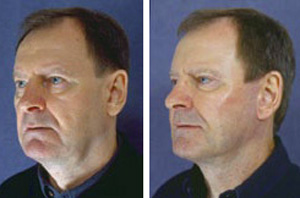
Men, being pragmatic, generally prefer to invest their time and money in lasting and satisfying solutions as opposed to more modest treatments that give lesser results and require multiple visits and ongoing investment.
Eyelid Surgery: This is commonly requested by male and female patients alike. The eyes are considered the “windows to the soul” and when heavy and puffy give the impression of self abuse, a lack of sleep and disinterest or sadness.
Bags under the eyes must also be addressed. Eyelid surgery in males, however, like facelift surgery, is different to that in females.
Men do not want a “glamourised” look. They want a natural one. With this knowledge, the plastic surgeon experienced in male aesthetic surgery will create a subtle result in the upper eyelids by removing excess skin and creating a gentle fold at the same time as reducing the fatty bags under the eyelids if necessary.

Rhinoplasty Surgery: A nose which is not in proportion to a person’s features in either men or women can detract from their overall appearance by interfering with the balance of their profile including the forehead and chin area.
Men often present for rhinoplasty after injury or trauma, and often from playing sport. In the case of trauma, it is critical to assess the patient’s breathing at the same time as considering nose surgery.
In these cases, I carry out functional testing on the breathing to ensure that if the tissues inside the nose are damaged or twisted that these be corrected at the same time as creating a more attractive nose. This procedure is more complicated and is known as a septorhinoplasty.
Communication with the patient prior to surgery is essential to understand the patient’s desires and for the patient to understand what is feasible surgically.
For this we use a digital imaging program called Alter-Image where the patient can share with us what type of result they are interested in and we can share with them the likely appearance of his new nose.
Unless the patient has previously had surgery elsewhere this is usually an excellent indication of what can be achieved by a highly experienced rhinoplastic surgeon.
Men do not want to have a “cute” nose or one that looks “operated on”. It is critical not to over-resect or remove too much tissue.
Men look masculine and more handsome with a stronger-profile nose. Secondary rhinoplasty is common in my practice where patients have had previous rhinoplasties by another surgeon or surgeons where their noses were over-resected or where there had been a lack of communication with the previous surgeon and the desired result was not achieved.
Surgery to correct over-resection usually requires a bone or cartilage graft to augment the over-resected contours of the nose. Understanding male aesthetics is critical in avoiding such misjudgment and the resulting dissatisfaction.
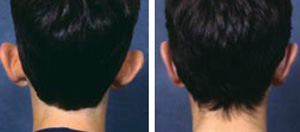
Otoplasty/Ear Reshaping: Protruding ears, commonly referred to as “bat ears”, are usually corrected during or prior to the teenage years.
For men, this can be especially distressing as short hair accentuates the problem and can make wearing a hat or helmet difficult and uncomfortable.
The cruelly-named “Dumbo look” is not appreciated by the self-conscious young male and can be corrected with an otoplasty (ear reshaping procedure) which both reshapes the ear and sets it back against the side of the head.
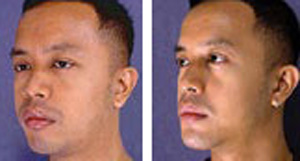
Facial Implants/Chin and Cheek: Facial implants alter the contour of the face and are popular with men who wish to have a stronger jaw or more angular face.
We commonly associate handsome men with having a strong lower third of face and a well defined jaw.
Lack of this definition weakens the strength and character of the face and for those seeking these attributes, a more masculine appearance might be attained with the use of facial implants.
The chin implant and cheek implant that I use are solid silicone implants. Although other implants are available, such as Porex, these are more difficult to insert, become very fixed in their position and are slightly more prone to infection.
The strong lower third of face profile obtained with a solid silicone implant placed through a small incision under the chin is generally permanent. The implants do not break and do not move over time.
Great care is necessary in placing these implants as the closeness of nerves to the lower lip must be appreciated by the operating surgeon.
On the cheek, the angularity of the face and high cheek bones can be enhanced by inserting cheek implants through a small incision in the upper part of the inside of the lip.
These implants have had a reputation of slipping and moving out of position but meticulous technique and care in inserting the implant rarely leads to problems.
The cheek implants are sometimes done in combination with the chin implants. The cheek implant similarly is close to a nerve on the cheek which supplies the upper lip and there is a danger of numbness to the upper lip, which at worst would be temporary and last for several weeks at most.
THE BODY
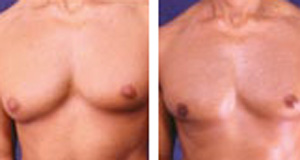
Gynaecomastia: A problem which is quite common although rarely publicly discussed is gynaecomastia or “man boobs”.
This generally appears in the young adults teenager of 15+ years where a growth spurt and/or puberty can lead to growth of the male breast tissue under the male nipple areolar complex, causing embarrassment.
This condition can also be associated with weight gain and obesity and also the taking of anabolic steroids for muscle enhancement. The embarrassment caused by this precludes the patient from removing their shirt in social situations and can make men embarrassed of intimacy.
The procedure to correct gynecomastia is sometimes viable with liposuction alone, although often liposuction is not enough because of the breast tissue which is very hard.
Liposuction is usually not satisfactory and a small incision has to be made under the nipple areolar complex through which the excess breast tissue can be surgically removed. This is an outpatient surgical procedure.
In the most extreme cases, the skin may have already lost its elasticity and may not fully retract after tissue removal which results in the need to resect skin as well.
In these cases, where more extensive skin resection is required, more extensive scarring is to be expected.
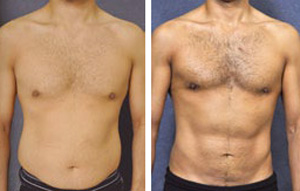
Liposuction: Men have a proclivity to develop fatty deposits around the abdomen, increasing their girth and “love handles” as well as on their backs.
More times than not, this fat is very resistant to diet and exercise and men generally present in their 20s to 40s for body contour surgery when they realise they are incapable of budging these fatty distributions. Even men in the fitness industry may have these localised fatty deposits despite their highly active lifestyles.
The procedure of liposuction, also known as liposculpture, can literally sculpt a more masculine physique and when combined with “skin etching” can create specific contours to give the “six-pack” appearance.
Liposuction is highly established as an outpatient surgical procedure and is generally performed under a light general anaesthesia.
I generally use ultrasonic technique, often in conjunction with the pneumatic technique, which reduces the trauma to the tissues and makes for the more rapid resolution of the swelling.
The patient wears a compressive garment post-operatively, generally similar to “skins” which are supportive and also help to remove the normal resultant swelling that occurs and which takes several weeks to months to resolve.
The small incisions used in the surgery heal imperceptibly and usually the patients are back to work within one week and full activities within four to six weeks. The result looks best at three months.
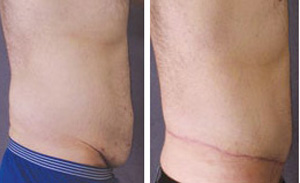
Contour surgery after massive weight loss: We all know that obesity is on the rise, especially in young men who are generally less active than in previous generations.
This inactivity with increased “screen time”, compounded with the rise and popularity of junk food have created a new, large group of patients who seek help because of massive weight gain.
Some are successful in reducing their weight by diet and exercise while others turn to gastric banding surgery which is becoming a specialty in itself.
Massive weight loss, regardless of how it is achieved, will often leave men and women with excess folds of skin that have failed to shrink with the reduction in bulk due to loss of elasticity.
The most common procedure I perform in this type of male patient is called a body lift or a male abdominoplasty with a circumferential extension around the back, where the extra skin in the abdomen and back is excised in a one-stage procedure.
There is a lengthy scar but this heals with time and patients are gratified to be able to wear fitting clothes and not have the discomfort or social concerns associated with sheets of skin hanging over their jeans.
In extreme cases in males, the skin on the thighs and arms may need to be reduced as well.
Unfortunately, the scarring is excessive in these areas and fades with time, but is the only answer for these patients who are trapped by their excessive skin who deserve the resultant comfort as a reward from losing a significant amount of weight.

Body implants: These have become increasingly popular over the last 25 years. I have 30 years’ experience with these types of implants and some patients have had these implants in situ without issue for these 30 years.
The concept was originally introduced in the form of calf implants into the plastic surgery fraternity by a Canadian surgeon, Dr Carlson, in the late 1970s to repair patients who had withered legs from polio.
Body implants are solid silicone implants which can be pre-fabricated or custom manufactured to correct contour deformities in the calves, buttocks, pectorals and arms. These implants are inserted through small incisions.
Today, the most common area for solid silicone body implants remains the calves. This is an especially difficult area to build up with exercise and men with skinny calves, sometimes referred to as “bird legs”, seek out this surgery as they are embarrassed when wearing shorts.
These solid implants come in a variety of sizes and are inserted through a small incision in the back of the knee with an almost inconspicuous small scar.
As stated, another body implant used in males is the buttock implant indicated for younger men with a flat butt but especially as men age.
The butt can become very flat with age and men can appear withered and aged in shorts, pants or swimmers. Buttock implants are inserted through a small incision near the gluteal crease and enhance the fullness of the male butt.
The more specialised implants used include pectoral implants for patients who are puny. These are inserted through small incisions underneath the armpits and come in a variety of sizes and shapes.
Male patients who are ex-athletes also present with torn muscles. I have created specialised implants for patients for the biceps and deltoid muscles to help restore the contour of their arm or their shoulder.
My experience with solid silicone implants over a very long period of time, in hundreds of cases, is that they give very few long term problems.
Unlike a breast implant, they are solid, not liquid. They cannot break and rarely move, but care is necessary to place them as deeply as possible as they can have a “show” underneath the skin.
The surgeon must be also highly cognisant of the male aesthetic and what the patient needs to achieve rather than be cajoled into placing an inappropriately large implant which is likely to cause too much pressure on the skin and underlying tissues.
There are very few initial problems with these solid implants except that of seroma – fluid building around the area of surgery and patients must desist from extreme physical activity until the implant has settled into place which usually takes up to six weeks.
Hair transplantation: This is a specialised area with which a very few plastic surgeons or cosmetic surgeons are involved, even internationally. There are only a handful of surgeons in Australia who do this work, but a balding male can definitely be enhanced significantly by hair transplantation and we refer patients to appropriate regional surgeons for these procedures.
Penile enhancement: Another very specialised area of male cosmetic surgery which I am not experienced in. There are one or two surgeons in Australia who do this work and I refer patients to these surgeons.
SUMMARY
Male cosmetic surgery is increasing in popularity overall and has certainly increased in my practice in Double Bay, which is an affluent, urban setting.
This said, the men who present at the clinic come from all areas, professions, age groups and social strata with a view to enhancing their self image and improving their quality of life and perhaps social and professional status.
It is important as a cosmetic plastic surgeon to be highly aware of a patient’s motivation and resist the temptation to operate on an overly-narcissistic patient, or one suspected of having body dysmorphic disorder.
Especially in the male rhinoplastic patient who has had multiple operations, the finicky patient, the patient who is obsessed with their appearance, the constant facial groomer – potential signs they are suffering from Body Dysmorphia – the temptation by the patient to try to improve on an already satisfactory situation should be curbed.
Be that as it may, males represent a potentially very satisfied group of patients in cosmetic surgical practice.
- Dr Darryl Hodgkinson is recognised world-wide as an expert in cosmetic plastic surgery with more than 30 years of experience in both cosmetic and plastic/reconstructive surgery. Dr Hodgkinson did his plastic surgical training at the prestigious Mayo Clinic in the US and is among an elite group of a very few surgeons to hold two degrees in plastic surgery from American Board of Plastic and Reconstructive Surgeons and the Royal College of Surgeons, Canada. He is a past President of the Australasian College of Cosmetic Surgery and currently on their Board of Censors. All procedures are carried out by Darryl Hodgkinson and his experienced team at his licensed and accredited purpose-built facility, Cosmetic and Restorative Surgery Clinic and Double Bay Day Surgery. COSMETICSURGERYOZ.COM.AU




